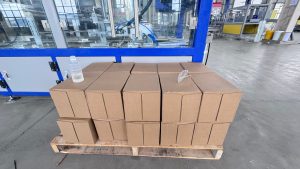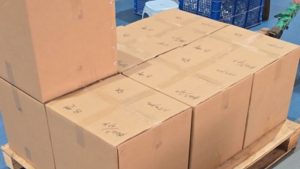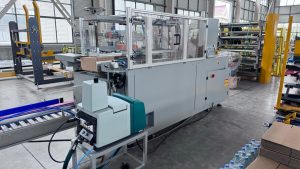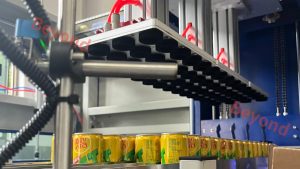In the world of industrial packaging, automation is essential for streamlining operations and boosting efficiency. Among the most commonly used automated systems are glue-based packing machines and tape-based packing machines. While both are designed to seal or secure packages, they use different methods and are suited for various applications. Understanding the differences between glue-based and tape-based packing machines can help businesses select the right solution to meet their specific needs.
glue-based packing machine tape-based packing machine
1. Introduction to Packing Machines
Packing machines are essential for the final stages of product packaging, delivering the efficiency and consistency needed in high-volume production environments. These machines typically handle tasks such as sealing, bundling, and securing products, using various techniques like gluing or taping. The two most common types of packing machines are:
- Glue-Based Packing Machines: These machines utilize adhesives such as glue, hot melt, or liquid adhesives to seal packages or secure products.
- Tape-Based Packing Machines: These machines employ adhesive tape, usually BOPP or PVC tape, to seal and secure packages.
Each type of machine offers distinct advantages depending on the nature of the packaging materials, the desired sealing strength, and the speed of production.
2. How Glue-Based Packing Machines Work
Glue-based packing machines are designed to apply adhesive to various surfaces, bonding packaging materials together. These systems typically feature a glue application unit that dispenses the adhesive, whether in liquid or solid form, followed by mechanisms that apply pressure to ensure proper adhesion. The adhesive can be applied to materials such as cardboard, paper, plastic, or other substrates, depending on the type of package being produced.
Types of Glue-Based Packing Machines:
- Hot Melt Glue Machines: These machines utilize heated adhesive that is melted and applied to packaging surfaces. The glue solidifies quickly upon contact, creating a strong bond. Hot melt glue is commonly used for carton sealing and product assembly.
- Cold Glue Machines: These machines use an adhesive that does not require heating. Cold glue is often preferred for more delicate applications where heat could damage the materials.
- Spray or Roller Glue Application: Some glue-based machines employ spray nozzles or rollers to apply an even layer of adhesive on packaging surfaces. This method is ideal for applications that require the adhesive to cover a larger area.
Applications:
- Carton Sealing: Glue-based machines are frequently used in industries such as food, pharmaceuticals, and consumer goods, where cartons or boxes must be securely sealed.
- Product Assembly: In some cases, glue-based machines are employed for assembling multi-part packaging, such as folding cartons or displays.
- Security Sealing:For tamper-proof or high-security packaging, glue-based machines can apply strong adhesives that create permanent seals.
3. How Tape-Based Packing Machines Work
Tape-based packing machines, on the other hand, utilize adhesive tape—such as BOPP, PVC, or kraft paper tape—to seal packages. These machines are equipped with tape dispensers that automatically feed tape onto the surface of the package, followed by mechanisms that press the tape into place and cut it to the desired length.
Types of Tape-Based Packing Machines:
- Automatic Tape Sealing Machines: These machines apply adhesive tape to carton seals with high precision, making them ideal for sealing the tops and bottoms of boxes.
- Strapping Machines: While primarily used for bundling items, strapping machines that utilize tape-based strapping also fall under the category of tape-based packing machinery. These machines apply pressure to secure the tape and bundle multiple items together.
- Case Erectors with Taping Units: These machines not only form cartons but also automatically apply tape to seal the cartons.
Applications:
- Carton Sealing: Tape-based machines are especially prevalent in shipping and logistics for sealing boxes and packages. They offer speed and efficiency, making them ideal for high-volume operations.
- Packing and Bundling: Tape-based packing machines are commonly used in warehousing and logistics to bundle multiple items together.
- General Packaging: For smaller or lighter items, tape machines provide a quick and efficient solution for sealing and securing products.
4. Key Differences Between Glue-Based and Tape-Based Packing Machines
While both types of packing machines serve the same fundamental purpose of sealing packages, there are several key differences between glue-based and tape-based systems:
| Feature | Glue-Based Packing Machine | Tape-Based Packing Machine |
|---|---|---|
| Sealing Method | Uses hot-melt glue to seal the flaps of cartons. | Uses adhesive tape to seal the flaps of cartons. |
| Cost of Consumables | Glue is typically cheaper in the long term, especially for high production. | Tape can be more expensive over time, as it needs frequent replacement. |
| Strength of Seal | Provides a very strong and durable seal, suitable for heavy-duty cartons. | Provides a moderately strong seal, sufficient for lighter loads. |
| Speed | Generally faster, as glue is applied and bonds quickly. | Slightly slower, as tape needs to be cut and applied. |
| Appearance | Clean and professional look with no visible tape lines. | Visible tape lines, which might not look as clean. |
| Maintenance | Requires regular cleaning to prevent glue buildup. | Easier maintenance, as no heating element is involved. |
| Production Volume Suitability | Ideal for large-scale, high-volume production. | Suitable for small to medium-scale production. |
| Application Environment | Performs well in hot or cold environments (temperature-resistant). | Tape adhesion can weaken in extreme heat or humidity. |
| Flexibility | Works well for irregular or custom-sized cartons. | Best for standard-sized cartons. |
| Initial Machine Cost | Typically more expensive due to the glue application system. | Generally more affordable upfront. |


glue-based packing machine carton picture tape-based packing machine carton picture
5. Advantages and Disadvantages of Each Type
Glue-Based Packing Machines
Advantages:
- Stronger Seals: Glue offers a more robust and permanent seal, making it ideal for products that require secure packaging or tamper-proof seals.
- Versatility: Glue-based systems can be used on a wider range of materials, including paper, cardboard, and plastics, and they accommodate various types of packages, from small boxes to complex multi-part assemblies.
- Durability: These machines are often preferred for applications requiring packaging that will be handled extensively, such as when shipping heavy or fragile goods.
Disadvantages:
- Slower: The application and drying or curing of glue take more time, which can slow down the packing process.
- Higher Costs: Glue-based systems generally come with higher expenses, both for the machinery itself and for operational costs related to adhesive materials.
- Environmental Concerns: Some adhesives are not biodegradable, although there are eco-friendly options available.
Tape-Based Packing Machines
Advantages:
- Speed: Tape-based machines are generally faster since they don’t require curing or drying time, making them ideal for high-volume packaging operations.
- Cost-Effective: Tape is relatively inexpensive, and tape-based machines are typically simpler and more affordable.
- Simplicity: These machines are easy to operate and maintain, requiring less training and reducing maintenance efforts.
Disadvantages:
- Weaker Seals: While tape provides adequate sealing for most shipping needs, it may not deliver the same level of security or strength as glue, especially for heavier or fragile goods.
- Limited Material Use: Tape is best suited for sealing cardboard and paper materials but is less effective on certain types of packaging, such as plastics or specific composites.
6. Which is Best for You?
If there’s a need for high volumes, a strong seal, and a professional appearance, a glue-based packing machine would be the better option. However, if you’re seeking a lower upfront investment, easier maintenance, or are handling smaller production batches, a tape-based packing machine might be more suitable.
Feel free to reach out if you’d like more information or recommendations tailored to your specific requirements!
7. Conclusion
Both glue-based and tape-based packing machines offer unique advantages, making them suitable for various packaging needs. Glue-based machines excel in applications that require a strong, durable seal, particularly in industries with stringent security or shipping requirements. Conversely, tape-based machines are ideal for high-speed, cost-effective packaging tasks where speed and efficiency take precedence.
When selecting between glue-based and tape-based packing machines, businesses should consider factors such as production volume, material types, packaging requirements, and cost constraints. In many cases, a combination of both systems can be utilized across different stages of packaging to maximize efficiency and performance




